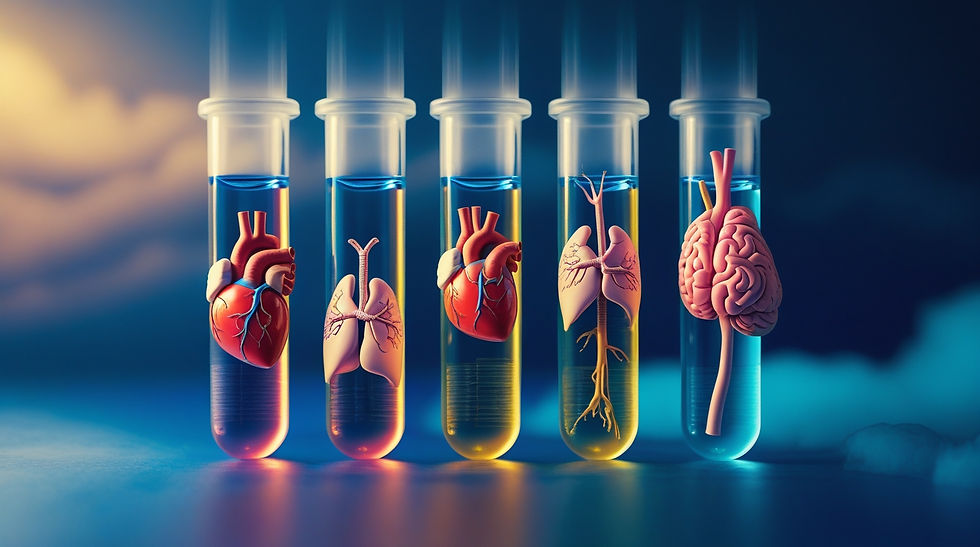Organoids: How Scientists are Using Tiny Human Organs to Revolutionize Medicine
- Mali Arwyn

- Jul 9
- 3 min read
Although scientists creating miniature human organs in a lab may sound like something from a sci-fi movie, it’s become a reality.

Organoids are tiny three-dimensional tissue cultures grown from stem cells that mimic the structure and function of human organs. They are essentially simplified versions of human organs that are enabling researchers to conduct testing in ways previously unimagined.
Organoid sizes range from the width of a hair to five millimeters. (1) They also differ from the real thing in that they lack the surrounding support found in vivo, such as from blood vessels, hormones and immune cells. Despite their deficits, the applications are extensive. Here are some of the ways organoids are being used to make medical breakthroughs.
Drug Testing
Scientists no longer have to rely solely on animal testing to assess the safety and efficacy of drugs. Since organoids can be derived from human cells, they can provide much more reliable results. This is speeding up the discovery of new medications.
Pancreatic cancer is widely considered one of the deadliest, hardest to treat cancers. Using an organoid-based automated drug-screening system, researchers at Weill Cornell Medicine were able to test over 6000 compounds for the treatment of pancreatic ductal adenocarcinoma. They discovered that a drug previously used to treat chest pain was effective in blocking and destroying cancerous growth, and also gained insight into the pathways mutations use to promote and sustain malignancy. (2) Similar testing is underway for the treatment of other types of cancer as well. (3)
Personalized Medicine
Organoids can be created from a patient’s own stem cells and used to predict how they will respond to a specific treatment. This is especially useful in cases of rare cancers and genetic conditions, when clinical trials aren’t possible.
In 2018, researchers at The Institute of Cancer Research and The Royal Marsden NHS Foundation Trust grew organoids derived from 110 metastatic cancer patients. Each organoid was given the same treatment as its donor. They found that 100 percent of the time, if a drug didn’t work on the organoid, it didn’t work on the patient, and that 88 percent of the time, if a drug worked on the organoid, it also worked on the patient. (4, 5, 6) Since then, using organoids for personalized medicine in a clinical setting has been studied for cancers, genetic disorders and autoimmune diseases. (7) Unfortunately, unless you’re part of a clinical trial, this type of treatment is not yet an option.
Infectious Disease
Researchers used human lung, intestine, brain, heart, liver, kidney and eye organoids to study how SARS-CoV-2 (COVID-19) affects the human body, and to develop drugs to treat it. Organoids aided in vaccine development and facilitate the study of emerging variants, which aids in the development of updated vaccines and booster protocols. (8, 9)
Norovirus, sometimes called the cruise ship virus, is the leading cause of acute diarrhea around the world. For decades, scientists were unable to grow it in a lab setting due to the fact that it is species specific (human Norovirus only grows in humans) and requires distinct conditions to replicate. Things changed in 2016 when researchers at Baylor College of Medicine used enteroids, or intestinal organoids, in conjunction with bile. (10) Since then scientists have been able to study why some people are genetically resistant, which disinfectants can limit spread, and potential treatments. (11, 12, 13)
Organoids are currently being used to study a vast array of bacterial, viral, fungal and parasitic infections. (14)
Regenerative and Transplant Medicine
Scientists are using skin organoids to generate new skin complete with pigmented hair follicles and sweat glands. This has never been done before and represents a major advance in wound healing and the treatment of severe burns. (15, 16) Liver organoids have been used to regenerate and partially restore diseased liver tissue. (17) These applications are still experimental, and we’re a long way from full-scale organ replacement derived from organoids.
Limitations
At present, numerous barriers exist to widespread use of this technology. Lack of standardization makes reproducibility difficult. Varying donor cell sources, extracellular matrices, culture media and differentiation protocols can all lead to different results. Additionally, making organoids currently requires a great deal of time, expertise and financial resources. An automated system for their mass production has yet to be developed. (3, 6, 7, 14)
References
Assessed and Endorsed by the MedReport Medical Review Board






